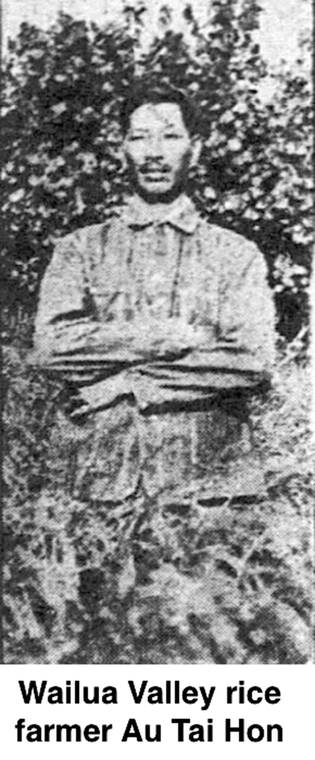Wailua Valley rice farmer Au Tai Hon (1888-1940), of Chinese ancestry, was born at Kapa‘a, Kaua‘i and was educated at Mid-Pacific Institute and Iolani.
Following graduation, he first worked in his father’s store in Kapa‘a, and then went to the Imperial Valley in California to work on an orchard for several years.
He returned to Kaua‘i in 1924 to cultivate rice in Wailua Valley.
In 1926, when he was interviewed by a “Honolulu Star-Bulletin” correspondent, he was leasing a 33-acre plot of government land and was preparing to harvest the finest crop of rice in the entire Wailua Valley.
His farm was a mass of waving golden grain and he expected to harvest an average of 40 bags of rice per acre.
In explaining his success, Hon said, “’That land, for instance,” while pointing his finger at a rice patch, “contains too much alkali; I flooded that land, and I will do that again for several years. By and by, I will wash all the alkali out of the soil.”
Pointing to another rice patch, Hon noted, “That is my prize patch. I call it my ‘select patch,’ because every seedling of rice there was carefully selected by hand from the planting bed.”
He also learned that using fertilizer increased yields when administered at the right time and in the right amount.
Some of his patches were less costly ratoon patches, in which the rice grew from the stubble of a previously harvested crop planted with seedlings.
Although he expected to harvest only about one-third as much rice from his ratoon patches as from his planted patches, his ratoon patches had saved him the cost of planting.
The only expenses he incurred from his ratoon patches were for fertilizer, labor for harvesting, and one or two men to keep the hungry rice birds (nutmeg mannikins) off.
Other costs were land rental and taxes.
From his combined plant and ratoon patches, and with rice selling at $6.75 per bag, he expected a gross profit of about $8,910.
And, with expenses comparatively small, he anticipated a substantial net profit.


